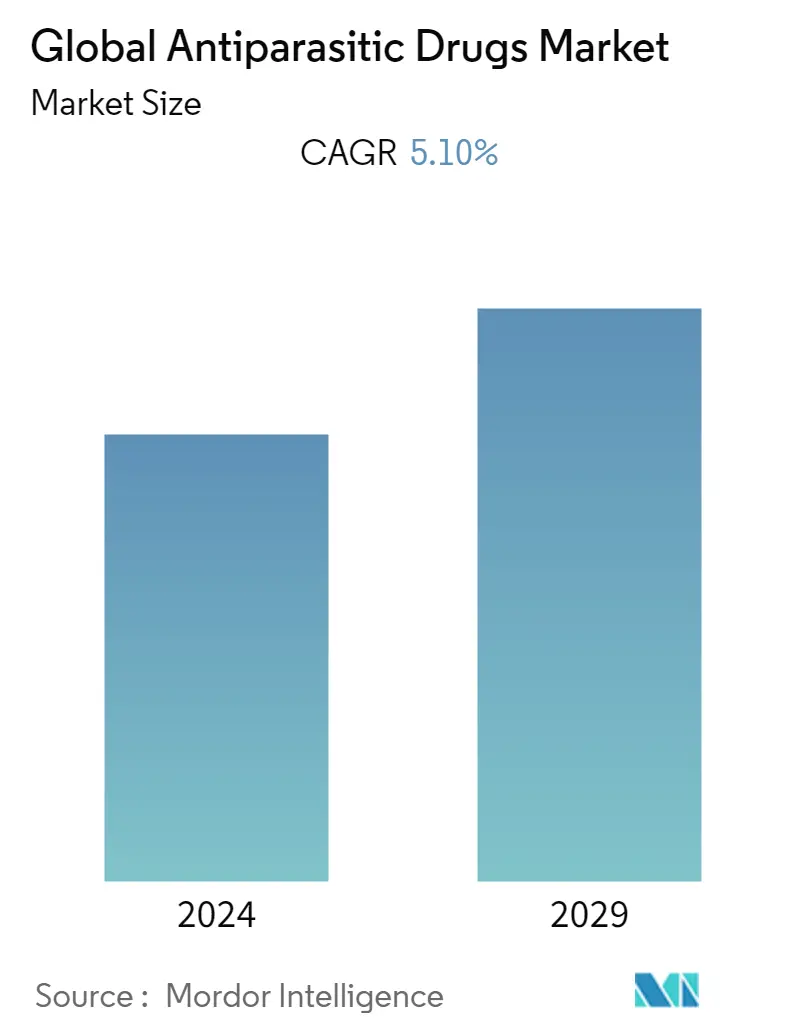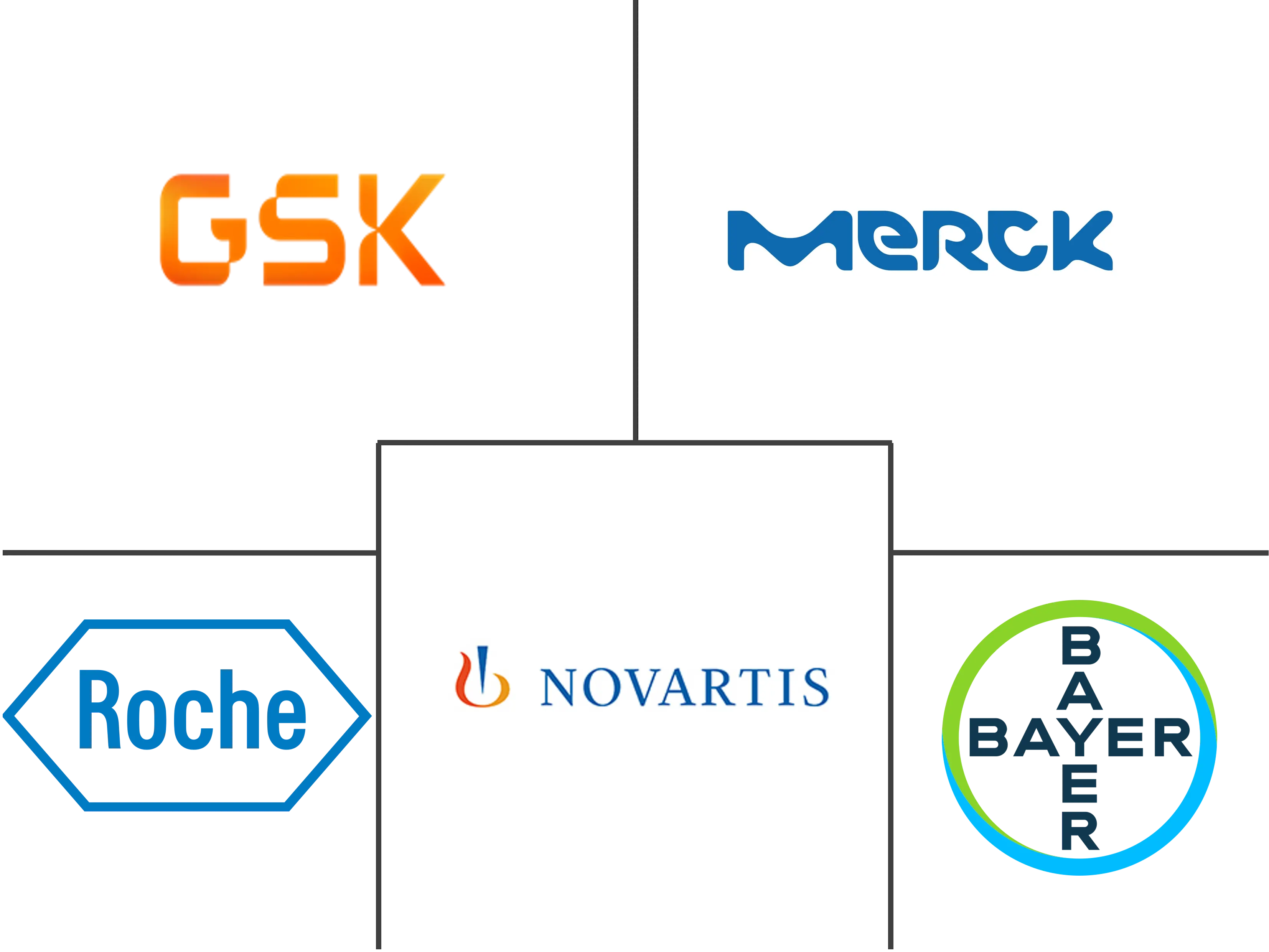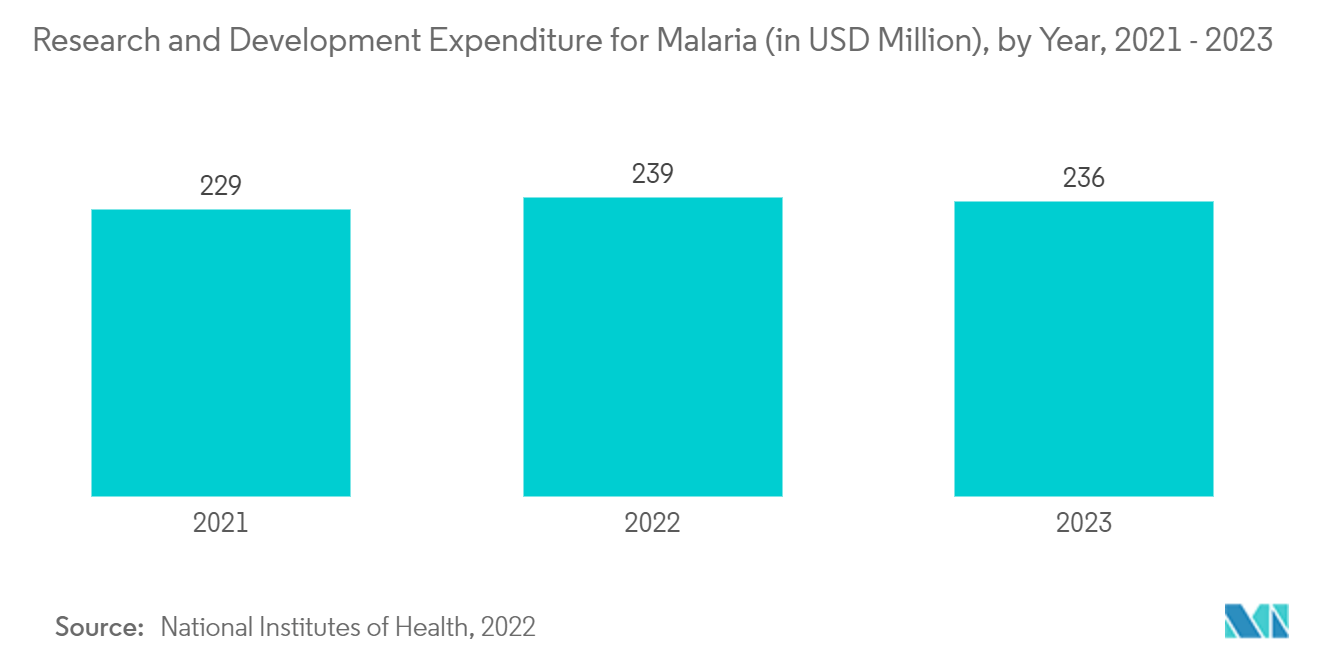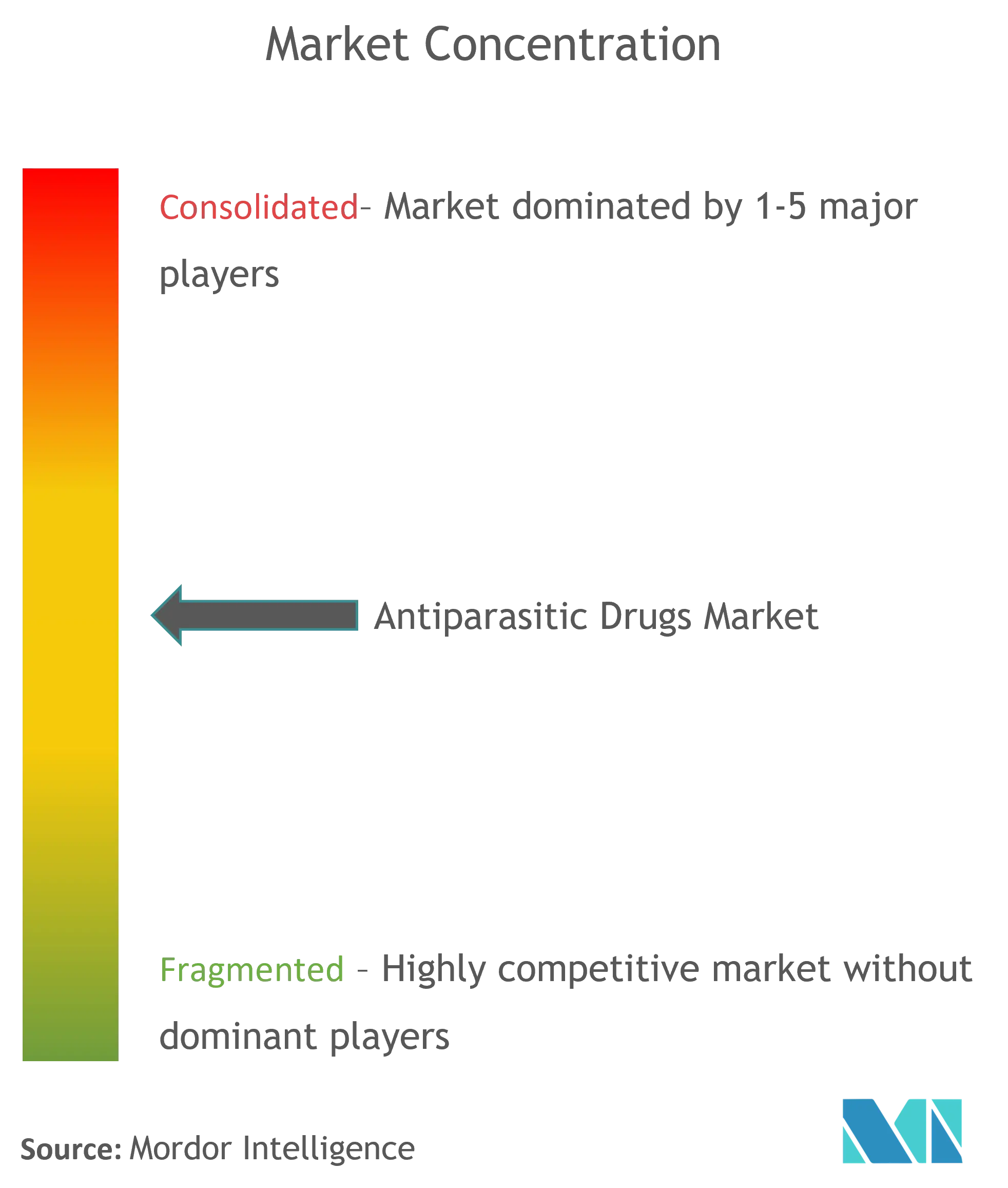Anti-Parasitic Drugs Market Size

| Study Period | 2019 - 2029 |
| Base Year For Estimation | 2023 |
| Forecast Data Period | 2024 - 2029 |
| CAGR | 5.10 % |
| Fastest Growing Market | Asia-Pacific |
| Largest Market | North America |
Major Players
*Disclaimer: Major Players sorted in no particular order |
Anti-Parasitic Drugs Market Analysis
The antiparasitic drugs market is projected to grow with a CAGR of 5.1% during the forecast period (2022 - 2027).
The COVID-19 outbreak has had a significant impact on the market. As employment closures have curtailed import and export activities, there has been a considerable influence on the market, resulting in shortages and unavailability of antiparasitic drugs and supplies across healthcare facilities. Due to the temporary shutdown of production facilities, export restrictions, increased demand for the COVID-19 medication, disruptions in the supply of goods, and interruptions in services, the impact of the outbreak in its initial phase on the antiparasitic drugs market was substantial. As per the data published by the World Health Organization (WHO), in 2020, most malaria-endemic countries faced moderate disruptions in anti-parasitic service delivery. However, the demand for treating COVID-19 with different drugs, such as antiviral and anti-parasitic, witnessed a significant boost in 2021. Clinical trials were undertaken to observe the effect of these drugs on novel coronavirus. For instance, according to the National Center for Biotechnology Information article titled "From hydroxychloroquine to Ivermectin: What are the Antiviral Properties of Anti-Parasitic Drugs to Combat SARS-CoV-2", published in February 2021, it was observed that chloroquine, hydroxychloroquine, artemisinins, and nitazoxanide showed some antiviral activity in vitro studies to reduce the viral replication stage by affecting cellular organelles.
Furthermore, according to the research study published by the British Heart Foundation, in April 2021, titled "Antiparasitic Drug Could Prevent Covid-19 Lung Damage," it was concluded that Niclosamide could protect cells against COVID-19-induced cell death. As per the same source, researchers observed that mefloquine demonstrates antiviral activity against coronaviruses by inhibiting the cytopathic effect of two coronaviruses closely related to SARS-CoV-2- the pangolin coronavirus GX_P2V/pangolin and feline coronavirus. The most effective drug among the anti-parasitic drug classes was Ivermectin, which was approved by the United States Food and Drug Administration (FDA) for therapeutic use among coronavirus patients. Likewise, according to the National Center for Biotechnology Information data, in April 2021, it was found that Ivermectin, an anti-parasitic drug, inhibited the SARS-CoV-2 virus growth by removing all the viral RNA from growing in cell culture within 48 hours. Therefore, initially, the growth of the anti-parasitic drugs market was hampered due to the government's restrictions on the COVID-19 pandemic. However, the market is anticipated to gain traction due to the increasing demand for antiparasitic drugs for treating COVID-19 patients and the growth in the number of drug trials for COVID-19 treatment.
Furthermore, major factors contributing to the growth of the antiparasitic drug market include the increasing prevalence of parasitic infections such as Chagas Disease, the surge in research and development activities of companies to launch antiparasitic drugs, and the initiatives taken by the government and non-profit groups to raise public awareness of parasitic infections and provide appropriate treatment. For instance, according to the World Health Organization (WHO) updates from April 2022, around 6-7 million people were diagnosed with Chagas Disease, a parasitic infection caused by the Trypanosoma cruzi parasite. Moreover, the World Health Organization announced a series of guidelines in June 2020 to control a parasitic neglected tropical disease, Schistosomiasis, to eliminate it as a public health problem by 2025 and make the world a "World Free Schistosomiasis."
In addition, the rising research and development activities and an increasing number of company collaborations for developing product pipelines are providing beneficial opportunities for the antiparasitic drugs market over the forecast period. For instance, in April 2021, Janssen Pharmaceutica NV collaborated with WEHI, an Australian Medical Research Center, to develop potential new antimalarial drug candidates. The collaborative research team discovered compounds with antimalarial activity within a collection of 80,000 drug-like molecules in the Janssen Jump-stARter Compound Library. The researchers towards potential antimalarial drugs are further developing the most promising candidates. Moreover, in May 2021, Bajaj Healthcare launched its new anti-parasitic drug, Ivejaj, which can be used to treat COVID infections. The company has received approval from India's drug regulator, DCGI, to manufacture and market the tablets. Additionally, in April 2021, Janssen Pharmaceutica NV collaborated with an Australian medical research institute, WEHI, to develop potential new antimalarial drug candidates. A collaborative research team discovered compounds with antimalarial activity within a collection of 80,000 drug-like molecules in the Janssen Jump-stARter Compound Library. The researchers towards potential antimalarial drugs are further developing the most promising candidates.
However, the adverse effects and risks associated with anti-parasitic drugs and a lack of awareness among the rural population in developing and underdeveloped economies are expected to hamper the growth of the antiparasitic drugs market.
Anti-Parasitic Drugs Market Trends
This section covers the major market trends shaping the Anti-Parasitic Drugs Market according to our research experts:
Antiprotozoals Segment is Expected to Witness Growth Over the Forecast Period
Antiprotozoals are anticipated to witness the fastest growth during the forecast period owing to the increasing prevalence of malaria, increasing emphasis of companies on developing these drugs
Protozoan diseases are becoming more common worldwide, and a lack of effective medicine aggravates this due to drug resistance and the toxicity of present antiprotozoal medications. These parasite infections cause mortality and morbidity worldwide, affecting around 500 million people.
Antiprotozoals are expected to hold a significant market share in the antiparasitic drugs market owing to the increasing prevalence of malaria in developing and under-developed countries such as India, Africa, and other Southeast Asian countries. As per the "World Malaria Report" published by World Health Organization (WHO) in December 2021, 29 of the 85 malaria-endemic countries accounted for 96% of all malaria cases in 2020. India contributed approximately 1.7% of malaria cases. According to the same source, there were an estimated 241 million malaria cases in 2020, compared to 227 million cases in 2019. Such an increase in disease infections will likely drive the demand for antiprotozoal drugs over the coming years.
Furthermore, the increasing emphasis of companies on developing these drugs is expected to drive the growth of the antiprotozoal drugs segment over the forecast period. For instance, in January 2020, Shin Poong and Medicines for Malarial Venture developed an antimalarial drug, Pyramax, to reduce the increasing number of malarial-induced ailments in Nigeria. Moreover, artemisinin drugs with antiprotozoal activity are considered the first line of treatment in combination with other antimalarial drugs to reduce the resistance developed by the malaria parasite Plasmodium falciparum against artemisinin when administered alone. For instance, artemether-lumefantrine (Coartem) and artesunate-mefloquine are recommended as artemisinin-based combination therapies. Moreover, according to the World Health Organization data published in March 2020, artemisinin is effective against all Plasmodium parasitic protozoa that cause malaria. The drug effectively treats infections caused by chloroquine-resistant parasites and infections caused by multidrug-resistant P. falciparum, the deadliest malaria protozoans.
Thus, these factors are anticipated to contribute to the segment's growth during the forecast period.

North America is Expected to Have the Significant Market Share Over the Forecast Period
North America is expected to hold a major market share in the antiparasitic drug market due to the increasing prevalence of malaria infection, growing awareness, an increasing number of strategic initiatives undertaken by prominent players, the surge in research and development activities, and increasing migration to North America through the Central American isthmus. For instance, according to the World Health Organization, in 2021, more than 723,000 cases of malaria were reported in America. Furthermore, as per the data published by the Sepsis Organization, in May 2021, toxoplasmosis and Giardia infections are the two most common parasitic infections in North America.
Furthermore, in June 2021, researchers in Canada warned that a new cancer-like parasite responsible for causing alveolar echinococcosis (AE) is anticipated to emerge in North America. Alveolar echinococcosis (AE) is a rare parasitic condition caused by the tapeworm Echinococcus multilocularis infecting the lungs. These worms can infect a variety of mammals. Most people become infected by ingesting microscopic eggs from contaminated food or handling infected animals. Such an increase in the prevalence of parasitic infections is likely to boost the market's growth in the North American region.
Similarly, an article titled "Malaria in the USA: How Vulnerable Are We to Future Outbreaks?" published in January 2021 in PubMed Central, stated that despite the absence of recent autochthonous cases in the United States, numerous factors indicate that local malaria outbreaks will remain a public health threat in the United States, including large numbers of international visitors from endemic areas, multiple Anopheles species capable of transferring the parasite, and inadequate vector-borne disease preparedness.
Thus, these factors are likely to drive the growth of the antiparasitic drugs market in the North American region.

Anti-Parasitic Drugs Industry Overview
The global key players are manufacturing the majority of the anti-parasitic drugs. Market leaders with more funds for research and a better distribution system have established their position in the market. Some key players include F. Hoffmann-La Roche, Novartis AG, GlaxoSmithKline PLC, Sanofi, and Pfizer.
Anti-Parasitic Drugs Market Leaders
-
GlaxoSmithKline plc
-
Merck KGaA
-
Novartis AG
-
F. Hoffmann-La Roche Ltd
-
Bayer AG
*Disclaimer: Major Players sorted in no particular order

Anti-Parasitic Drugs Market News
- In June 2022, Lyndra Therapeutics dosed the first participant in its Phase I clinical trial investigating oral biweekly ivermectin (LYN-163) to fight malaria.
- In March 2022, May & Baker Nigeria PLC launched a new drug, Artelum Combo, to combat malaria parasites across the country. The medicine is a one-of-a-kind combination of Arthemeter Lumefantrine and Paracetamol that provides complete malaria therapy in a single package.
Anti-Parasitic Drugs Market Report - Table of Contents
1. INTRODUCTION
- 1.1 Study Assumptions and Market Definition
- 1.2 Scope of the Study
2. RESEARCH METHODOLOGY
3. EXECUTIVE SUMMARY
4. MARKET DYNAMICS
- 4.1 Market Overview
-
4.2 Market Drivers
- 4.2.1 Increasing Prevalence of Parasitic Infections
- 4.2.2 Increasing Investment in Research and Development Activities
-
4.3 Market Restraints
- 4.3.1 Adverse Effects and Risk Associated with the Drugs
-
4.4 Porter's Five Forces Analysis
- 4.4.1 Threat of New Entrants
- 4.4.2 Bargaining Power of Buyers/Consumers
- 4.4.3 Bargaining Power of Suppliers
- 4.4.4 Threat of Substitute Products
- 4.4.5 Intensity of Competitive Rivalry
5. MARKET SEGMENTATION (Market Size by Value - in USD Million)
-
5.1 By Drug Type
- 5.1.1 Anthelmintics
- 5.1.2 Antiprotozoals
- 5.1.3 Others
-
5.2 By Route of Administration
- 5.2.1 Oral
- 5.2.2 Injectable
- 5.2.3 Topical
-
5.3 By Distribution Channel
- 5.3.1 Hospital Pharmacy
- 5.3.2 Retail Pharmacy
- 5.3.3 Others
-
5.4 Geography
- 5.4.1 North America
- 5.4.1.1 United States
- 5.4.1.2 Canada
- 5.4.1.3 Mexico
- 5.4.2 Europe
- 5.4.2.1 Germany
- 5.4.2.2 United Kingdom
- 5.4.2.3 France
- 5.4.2.4 Italy
- 5.4.2.5 Spain
- 5.4.2.6 Rest of Europe
- 5.4.3 Asia-Pacific
- 5.4.3.1 China
- 5.4.3.2 Japan
- 5.4.3.3 India
- 5.4.3.4 Australia
- 5.4.3.5 South Korea
- 5.4.3.6 Rest of Asia-Pacific
- 5.4.4 Middle-East and Africa
- 5.4.4.1 GCC
- 5.4.4.2 South Africa
- 5.4.4.3 Rest of Middle-East and Africa
- 5.4.5 South America
- 5.4.5.1 Brazil
- 5.4.5.2 Argentina
- 5.4.5.3 Rest of South America
6. COMPETITIVE LANDSCAPE
-
6.1 Company Profiles
- 6.1.1 GlaxoSmithKline plc
- 6.1.2 Merck KGaA
- 6.1.3 Novartis AG
- 6.1.4 Bayer
- 6.1.5 F. Hoffmann-La Roche Ltd
- 6.1.6 Zydus Group
- 6.1.7 Sanofi
- 6.1.8 Mankind Pharma
- 6.1.9 Cipla Ltd
- 6.1.10 Ipca Laboratories Ltd.
- *List Not Exhaustive
7. MARKET OPPORTUNITIES AND FUTURE TRENDS
** Subject To AvailablityAnti-Parasitic Drugs Industry Segmentation
As per the scope of the report, anti-parasitic drugs are used to treat various parasitic diseases, such as those caused by parasitic fungi, protozoa, helminths, ectoparasites, and amoeba, among many others. These drugs target and attack the parasitic agents of various infections and destroy or restrain their growth and development. The Global Antiparasitic Drugs Market is segmented by Drug Type (Anthelmintics, Antiprotozoals, and Others), Route of Administration (Oral, Injectable, and Topical), Distribution Channel (Hospital Pharmacy, Retail Pharmacy, and Others), and Geography (North America, Europe, Asia-Pacific, Middle East, and Africa, South America). The report offers the value (USD million) for the above segments. The market report also covers the estimated market sizes and trends for 17 countries across major regions globally. The report offers the value (USD million) for the above segments.
| By Drug Type | Anthelmintics | |
| Antiprotozoals | ||
| Others | ||
| By Route of Administration | Oral | |
| Injectable | ||
| Topical | ||
| By Distribution Channel | Hospital Pharmacy | |
| Retail Pharmacy | ||
| Others | ||
| Geography | North America | United States |
| Canada | ||
| Mexico | ||
| Geography | Europe | Germany |
| United Kingdom | ||
| France | ||
| Italy | ||
| Spain | ||
| Rest of Europe | ||
| Geography | Asia-Pacific | China |
| Japan | ||
| India | ||
| Australia | ||
| South Korea | ||
| Rest of Asia-Pacific | ||
| Geography | Middle-East and Africa | GCC |
| South Africa | ||
| Rest of Middle-East and Africa | ||
| Geography | South America | Brazil |
| Argentina | ||
| Rest of South America |
Anti-Parasitic Drugs Market Research FAQs
What is the current Global Antiparasitic Drugs Market size?
The Global Antiparasitic Drugs Market is projected to register a CAGR of 5.10% during the forecast period (2024-2029)
Who are the key players in Global Antiparasitic Drugs Market?
GlaxoSmithKline plc, Merck KGaA, Novartis AG, F. Hoffmann-La Roche Ltd and Bayer AG are the major companies operating in the Global Antiparasitic Drugs Market.
Which is the fastest growing region in Global Antiparasitic Drugs Market?
Asia-Pacific is estimated to grow at the highest CAGR over the forecast period (2024-2029).
Which region has the biggest share in Global Antiparasitic Drugs Market?
In 2024, the North America accounts for the largest market share in Global Antiparasitic Drugs Market.
What years does this Global Antiparasitic Drugs Market cover?
The report covers the Global Antiparasitic Drugs Market historical market size for years: 2019, 2020, 2021, 2022 and 2023. The report also forecasts the Global Antiparasitic Drugs Market size for years: 2024, 2025, 2026, 2027, 2028 and 2029.
Global Antiparasitic Drugs Industry Report
Statistics for the 2024 Global Antiparasitic Drugs market share, size and revenue growth rate, created by Mordor Intelligence™ Industry Reports. Global Antiparasitic Drugs analysis includes a market forecast outlook to 2029 and historical overview. Get a sample of this industry analysis as a free report PDF download.



